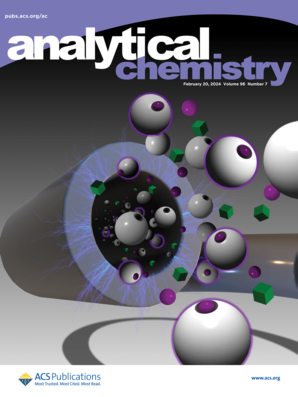An Enzyme-Triggered Au–Se Nanodevice for Precise Imaging of MicroRNA
IF 6.7
1区 化学
Q1 CHEMISTRY, ANALYTICAL
引用次数: 0
Abstract
In situ imaging of microRNA (miRNA) in tumor cells is vital for clinical diagnosis and pathological research. However, achieving high-precision imaging is always limited by undesirable background signals. Herein, we introduced a gold–selenium-based nanodevice (AuSeND) for high-fidelity imaging of miRNA via enzyme-triggered catalytic hairpin assembly (CHA). This system employs an enzyme-activatable CHA circuit, constructed by extending a short tail at the 3′ end of hairpin H1 with an apurinic/apyrimidinic (AP) site. The CHA circuit components are connected to the surface of AuNPs via Au–Se bonds, forming a Au–Se nanodevice. It remains inactive in normal cells, while in tumor cells, the CHA circuit is activated by apurinic/apyrimidinic endonuclease 1 (APE1) in the cytoplasm, generating a fluorescence signal under miRNA stimulation for miRNA imaging. The developed AuSeND enables cancer cell-selective miRNA imaging and improves the signal-to-noise ratio by combining the high stability of the Au–Se bond with the specific regulation of the APE1 enzyme, offering strong potential for clinical diagnostic applications.

酶触发Au-Se纳米器件用于MicroRNA的精确成像
肿瘤细胞microRNA (miRNA)的原位成像对临床诊断和病理研究具有重要意义。然而,实现高精度成像总是受到不良背景信号的限制。在此,我们引入了一种基于金硒的纳米器件(AuSeND),通过酶触发的催化发夹组装(CHA)对miRNA进行高保真成像。该系统采用酶激活的CHA电路,通过在发夹H1的3 '端延伸带有apurinic/apyrimidinic (AP)位点的短尾构建。CHA电路元件通过Au-Se键连接到aunp表面,形成Au-Se纳米器件。在正常细胞中处于失活状态,而在肿瘤细胞中,CHA回路被细胞质中的APE1激活,在miRNA刺激下产生荧光信号,进行miRNA成像。开发的AuSeND通过将Au-Se键的高稳定性与APE1酶的特异性调节相结合,实现了癌细胞选择性miRNA成像,提高了信噪比,具有很强的临床诊断应用潜力。
本文章由计算机程序翻译,如有差异,请以英文原文为准。
求助全文
约1分钟内获得全文
求助全文
来源期刊

Analytical Chemistry
化学-分析化学
CiteScore
12.10
自引率
12.20%
发文量
1949
审稿时长
1.4 months
期刊介绍:
Analytical Chemistry, a peer-reviewed research journal, focuses on disseminating new and original knowledge across all branches of analytical chemistry. Fundamental articles may explore general principles of chemical measurement science and need not directly address existing or potential analytical methodology. They can be entirely theoretical or report experimental results. Contributions may cover various phases of analytical operations, including sampling, bioanalysis, electrochemistry, mass spectrometry, microscale and nanoscale systems, environmental analysis, separations, spectroscopy, chemical reactions and selectivity, instrumentation, imaging, surface analysis, and data processing. Papers discussing known analytical methods should present a significant, original application of the method, a notable improvement, or results on an important analyte.
 求助内容:
求助内容: 应助结果提醒方式:
应助结果提醒方式:


